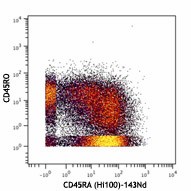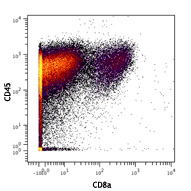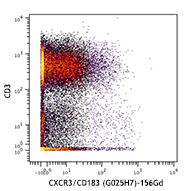- Clone
- HI100 (See other available formats)
- Regulatory Status
- RUO
- Workshop
- IV N906
- Other Names
- GP180, L-CA, LCA, LY5, T200, PTPRC
- Isotype
- Mouse IgG2b, κ
- Ave. Rating
- Submit a Review
- Product Citations
- publications

-

Human PBMCs stained with 149Sm-anti-CD45RO (UCHL1) and 143Nd-anti-CD45RA (HI100). Lymphocytes are displayed in the analysis. Data provided by DVS Sciences.
| Cat # | Size | Price | Quantity Check Availability | Save | ||
|---|---|---|---|---|---|---|
| 304143 | 100 µg | 104€ | ||||
CD45RA is a 205-220 kD single chain type I glycoprotein. It is an exon 4 splice variant of the tyrosine phosphatase CD45. The CD45RA isoform is expressed on resting/naïve T cells, medullary thymocytes, B cells and monocytes. CD45RA enhances both T cell receptor and B cell receptor signaling. CD45 non-covalently associates with lymphocyte phosphatase-associated phosphoprotein (LPAP) on T and B lymphocytes. CD45 has been reported to be associated with several other cell surface antigens including CD1, CD2, CD3, and CD4. CD45 has also been reported to bind galectin-1. CD45 isoform expression can change in response to cytokines.
Product DetailsProduct Details
- Reactivity
- Human
- Antibody Type
- Monoclonal
- Host Species
- Mouse
- Formulation
- Phosphate-buffered solution, pH 7.2, containing 0.09% sodium azide and EDTA.
- Preparation
- The antibody was purified by affinity chromatography.
- Concentration
- 1.0 mg/ml
- Storage & Handling
- The antibody solution should be stored undiluted between 2°C and 8°C.
- Application
-
FC - Quality tested
CyTOF® - Verified - Recommended Usage
-
This product is suitable for use with the Maxpar® Metal Labeling Kits. For metal labeling using Maxpar® Ready antibodies, proceed directly to the step to Partially Reduce the Antibody by adding 100 µl of Maxpar® Ready antibody to 100 µl of 4 mM TCEP-R in a 50 kDa filter and continue with the protocol. Always refer to the latest version of Maxpar® User Guide when conjugating Maxpar® Ready antibodies.
- Application Notes
-
Additional reported applications (for relevant formats of this clone) include: inhibition of CD45 functions2, immunohistochemical staining of frozen tissue sections3 and formalin-fixed paraffin-embedded tissue sections4, and immunocytochemistry15,16.
- Additional Product Notes
-
Maxpar® is a registered trademark of Standard BioTools Inc.
-
Application References
(PubMed link indicates BioLegend citation) -
- Knapp W, et al. 1989. Leucocyte Typing IV. Oxford University Press. New York.
- Yamada T, et al. 2002. J. Biol. Chem. 277:28830. (WB, Block)
- Weninger W, et al. 2003 J. Immunol. 170:4638. (IHC-F)
- Imanguli MM, et al. 2009. Blood. 113:3620 (IHC-P)
- Roque S, et al. 2007. J. Immunol. 178:8028. (FC) PubMed
- Smeltz RB. 2007. J. Immunol. 178:4786. (FC) PubMed
- Palendira U, et al. 2008. Blood (FC) PubMed
- Kuttruff S, et al. 2009. Blood 113:358. (FC) PubMed
- Thakral D, et al. 2008. J. Immunol. 180:7431. (FC) PubMed
- Alanio C, et al. 2010. Blood 115:3718. (FC) PubMed
- Iannello A, et al. 2010. J. Immunol. 184:114. (FC) PubMed
- Yoshino N, et al. 2000. Exp. Anim. (Tokyo) 49:97. (FC)
- Guereau-de-Arellan M, et al. 2011. Brain. 134:3578. PubMed
- Canque B, et al. 2000. Blood 96:3748. (ICC)
- Imanguli MM, et al. 2009. Blood 13:3620. (ICC)
- Stoeckius M, et al. 2017. Nat. Methods. 14:865. (PG)
- Peterson VM, et al. 2017. Nat. Biotechnol. 35:936. (PG)
- Product Citations
- RRID
-
AB_2562822 (BioLegend Cat. No. 304143)
Antigen Details
- Structure
- Tyrosine phosphatases, type I transmembrane (exon 4 splicing of CD45 gene), 205-220 kD
- Distribution
-
B cells, naïve T cells, monocytes
- Function
- Enhances TCR and BCR signaling
- Ligand/Receptor
- Galectin-1, CD2, CD3, CD4
- Cell Type
- B cells, Monocytes, T cells, Tregs
- Biology Area
- Cell Biology, Immunology, Inhibitory Molecules, Neuroscience, Neuroscience Cell Markers
- Molecular Family
- CD Molecules
- Antigen References
-
1. Thomas M. 1989. Annu. Rev. Immunol. 7:339.
2. Trowbridge I, et al. 1994. Annu. Rev. Immunol.12:85. - Gene ID
- 5788 View all products for this Gene ID
- UniProt
- View information about CD45RA on UniProt.org
Related FAQs
- Can I obtain CyTOF data related to your Maxpar® Ready antibody clones?
-
We do not test our antibodies by mass cytometry or on a CyTOF machine in-house. The data displayed on our website is provided by Fluidigm®. Please contact Fluidigm® directly for additional data and further details.
- Can I use Maxpar® Ready format clones for flow cytometry staining?
-
We have not tested the Maxpar® Ready antibodies formulated in solution containing EDTA for flow cytometry staining. While it is likely that this will work in majority of the situations, it is best to use the non-EDTA formulated version of the same clone for flow cytometry testing. The presence of EDTA in some situations might negatively affect staining.
- I am having difficulty observing a signal after conjugating a metal tag to your Maxpar® antibody. Please help troubleshoot.
-
We only supply the antibody and not test that in house. Please contact Fluidigm® directly for troubleshooting advice: http://techsupport.fluidigm.com/
- Is there a difference between buffer formulations related to Maxpar® Ready and purified format antibodies?
-
The Maxpar® Ready format antibody clones are formulated in Phosphate-buffered solution, pH 7.2, containing 0.09% sodium azide and EDTA. The regular purified format clones are formulated in solution that does not contain any EDTA. Both formulations are however without any extra carrier proteins.
Customers Also Purchased
Compare Data Across All Formats
This data display is provided for general comparisons between formats.
Your actual data may vary due to variations in samples, target cells, instruments and their settings, staining conditions, and other factors.
If you need assistance with selecting the best format contact our expert technical support team.
 Login / Register
Login / Register 

















Follow Us